 |
Test System
We will be comparing the MSI 280 OC to the Sapphire 290X Tri-X.
- Intel Core i7-4960X @ 4.8 GHz
- Asus P9 X79-E WS Motherboard
- ADATA XPG V2 DDR3 2600 MHz 16 GB RAM kit
- Crucial MX100 512GB SSD
- Thermaltake Core V71 Case
- Thermaltake Water 3.0 Ultimate Cooler
- Thermaltake Toughpower 1350W Power Supply
3DMark
 |
 |
 |
 |
We start off our synthetic benchmarks with the benchmark staple, 3DMark. The Fire Strike test in particular is able to really test the limits of modern gaming machines.
Going up against the 280 and 290X, our 285 scored 7250, putting it just ahead of the 280.
Our overclock increased that number another 11%, bringing the total up to 8050, firmly ahead of the 280.
Furmark
 |
 |
 |
 |
FurMark is most known for its GPU stress test which can handily bring a graphics card to its max temp in just a few minutes.
Unfortunately it seemed to not agree with the brand new drivers required by the 285 and our score suffered because of this.
One thing to note though is that temps, even when overclocked, never rose above 60 degrees with the fans at 100%.
Unigine Heaven
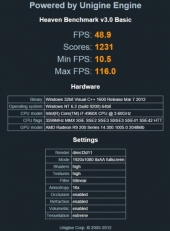 |
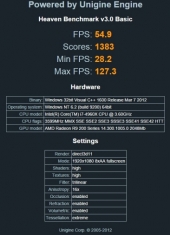 |
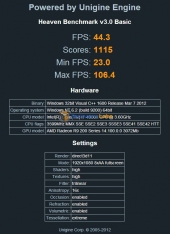 |
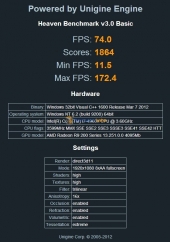 |
The heaven benchmark was designed to specifically test the key features in DirectX 11 and is an excellent benchmark for general GPU performance.
With all settings maxed out, our 285 averaged 48.9 fps, giving it a score of 1231 and edging out the 280 by a few fps.
That score went up 11% after the overclock, putting our average fps at nearly 55.
Unigine Valley
 |
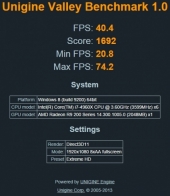 |
Valley is the newest benchmark from Unigine which utilizes dynamic sky, volumetric clouds, sun shafts, DOF, and ambient occlusion in order to really stress your GPU to the max.
Here our 285 averaged 36.4 fps and scored 1522 points. Our overclock bumped that up even further to 40.4 fps and a score of 1692.

[…] Sapphire R9 285 Dual-X OC Video Card Review @ TechwareLabs.com […]
[…] TechwareLabs comes back with the Sapphire R9 285 Dual-X OC Video Card […]
[…] Sapphire R9 285 Dual-X OC Video Card Review @ TechwareLabs.com […]
[…] Sapphire R9 285 Dual-X OC Video Card Review @ TechwareLabs.com […]